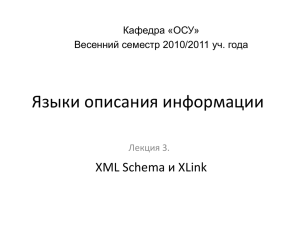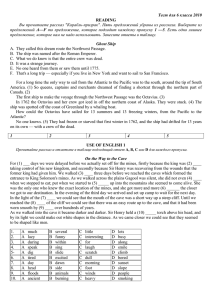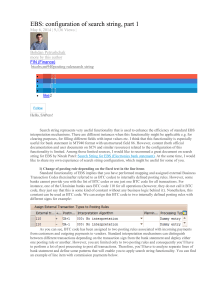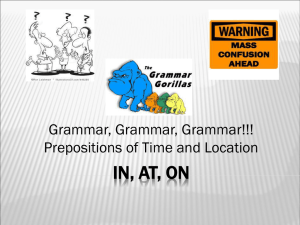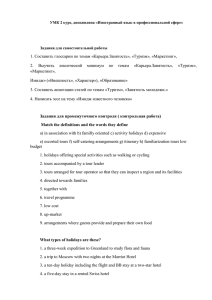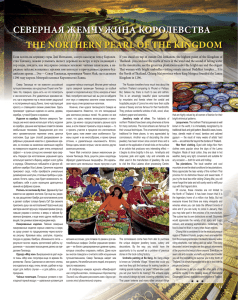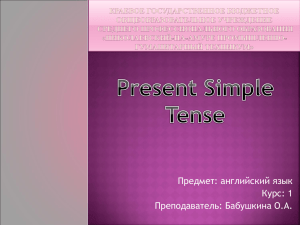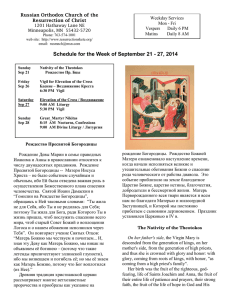Лекция 03 (XML Schema)
advertisement
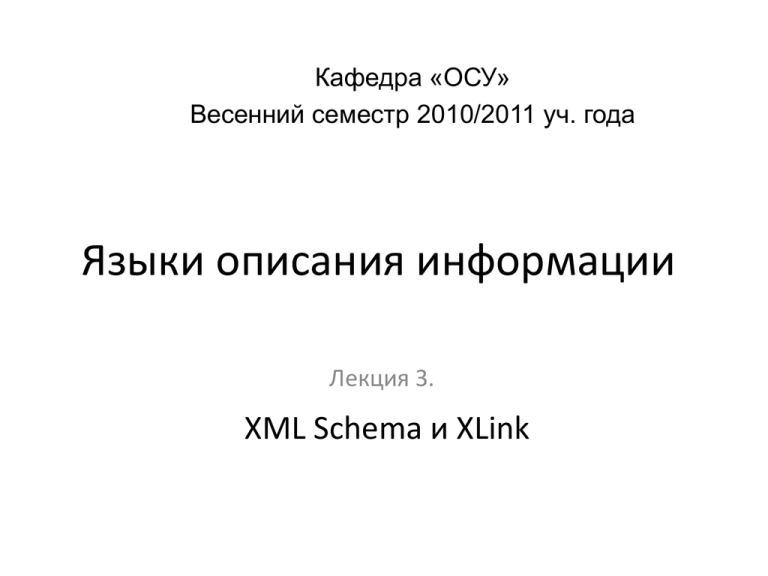
Кафедра «ОСУ»
Весенний семестр 2010/2011 уч. года
Языки описания информации
Лекция 3.
XML Schema и XLink
XSD (XML Schema Definition
Language)
XML Schema: альтернатива
использованию DTD
Стандарт XML Schema
• XML Schema это альтернатива языку DTD,
основанная на синтаксисе языка XML.
• XML 1.0 поддерживает DTD для определения
структуры документов.
• Язык XML Schema имеет лучшие возможности
поддержки для приложений, структуры
документов, атрибутов т типов данных.
• Будущие версии XML будут основываться на XML
Schema для определения типов XML документов.
• Стандарт XML Schema включает
– XML Schema Structures specifies the XML Schema
definition language.
– XML Schema Data types specifies extensible data types for
XML.
Спецификации XML Shema и временной
график их принятия
Specification
Draft / Proposal
Recommendation
XML Schema (XSD)
02. May 2001
XML Schema 1.0: Structures
02. May 2001
XML Schema 1.0: Datatypes
02. May 2001
XML Schema (2.Ed)
28. Oct 2004
XML Schema Structures (2.Ed)
28. Oct 2004
XML Schema Datatypes (2.Ed)
28. Oct 2004
XML Schema Component
Designators
17. Nov 2008
XML Schema 1.1: Structures
30. Apr 2009
XML Schema 1.1: Datatypes
30. Apr 2009
• Язык XML Schema позволяет описывать структуру XML
документа.
• Пример XML Schema:
<?xml version="1.0"?>
<xs:schema xmlns:xs="http://www.w3.org/2001/XMLSchema">
<xs:element name="note">
<xs:complexType>
<xs:sequence>
<xs:element name="to" type="xs:string"/>
<xs:element name="from" type="xs:string"/>
<xs:element name="heading" type="xs:string"/>
<xs:element name="body" type="xs:string"/>
</xs:sequence>
</xs:complexType>
</xs:element>
</xs:schema>
Введение в XML Schema
• Язык XML Schema предназначен для описания структуры
XML документов.
– Язык XML Schema также называется XML Schema Definition
(XSD).
• Целью создания языка XML Schema является описание
правильного синтаксиса конкретного языка разметки
(также, как и язык DTD).
• XML Schema определяет:
–
–
–
–
–
–
–
элементы, которые могут появляться в документах;
атрибуты, которые могут использоваться с элементами;
как элементы могут вкладываться друг в друга;
порядок следования дочерних элементов;
может ли элемент быть пустым или может ли он включать текст;
типы данных для элементов и атрибутов;
значения по умолчанию и фиксированные значения для
элементов и атрибутов.
• XML Schema является правопреемником
(заменителем) языка DTD.
• Считается, что скоро XML Schema будет использоваться
в большинстве Web приложений в качестве замены
для DTDs.
• Причинами этого является:
– XML Schema является расширяемым для будущих
дополнений;
– XML Schema более выразительный и более мощный, чем
DTD;
– XML Schema использует семантику метаязыка XML;
– XML Schema поддерживает типы данных;
– XML Schema поддерживает пространства име
(namespaces).
Почему нужно использовать XML
Schema
• Язык XML Schemas является более мощным по
сравнению с языком DTD.
– XML Schemas Support Data Types.
– XML Schemas use XML Syntax.
– XML Schemas Secure Data Communication.
– XML Schemas are Extensible.
– Well-Formed is not Enough.
Рассмотрим пример простого XMLдокумента (note.xml)
<?xml version="1.0"?>
<сообщение>
<для_кого> Луценко</для_кого>
<от_кого>Фролов</от_кого>
<заголовок>Напоминание</заголовок>
<содержание>
Не забудь о собрании лаборатории в субботу!
</содержание>
</сообщение>
Описание схемы на языке
XML Schema
• На языке XML Schema язык разметки использованный для составления XMLдокумента note.xml может быть описан следующим образом (файл note.xsd):
<?xml version="1.0"?>
<xs:schema xmlns:xs="http://www.w3.org/2001/XMLSchema"
targetNamespace="http://www.w3schools.com"
xmlns="http://www.w3schools.com"
elementFormDefault="qualified">
<xs:element name="note">
<xs:complexType>
<xs:sequence>
<xs:element name=“для_кого" type="xs:string"/>
<xs:element name="от_кого" type="xs:string"/>
<xs:element name="заголовок" type="xs:string"/>
<xs:element name="содержание" type="xs:string"/>
</xs:sequence>
</xs:complexType>
</xs:element>
</xs:schema>
• Связывание XML-документ note.xml с описанием его
синтаксиса на языке XML Schema можно выполнить
следующим образом:
<?xml version="1.0"?>
< сообщение xmlns="http://www.w3schools.com"
xmlns:xsl="http://www.w3.org/2001/XMLSchema-instance"
xsl:schemaLocation="http://www.w3schools.com note.xsd">
<для_кого>Луценко</для_кого>
<от_кого>Фролов</от_кого>
<заголовок>Напоминание</заголовок>
<содержание>
Не забудь о собрании лаборатории в субботу!
</содержание>
</сообщение>
• Здесь все используемые элементы, с помощью первого атрибута
объявлены в пространстве имен "http://www.w3schools.com".
• Во втором атрибуте
(xmlns:xsl="http://www.w3.org/2001/XMLSchema-instance")
создается префикс для пространства имен «XML Schema Instance»,
которое используется для связывания с экземплярами документов
описания схем на языке XSD.
• Из данного пространства имен можно использовать атрибут
schemaLocation, которому задается два значения, разделенные
пробелом.
– первое значение (http://www.w3schools.com) – это используемое
пространство имен,
– второе значение (note.xsd) – местоположение документа с описанием
XML схемы для данного пространства имен.
• Например:
xsl:schemaLocation="http://www.w3schools.com note.xsd"
Синтаксис языка XSD
• Корневым элементом описаний на языке XML Schema
является элемент <schema>:
<?xml version="1.0"?>
<xs:schema>
...
...
</xs:schema>
• Элемент <schema> может включать некоторые атрибуты.
Например:
<xs:schema xmlns:xs="http://www.w3.org/2001/XMLSchema"
targetNamespace="http://www.w3schools.com"
xmlns="http://www.w3schools.com"
elementFormDefault="qualified">
• Первый атрибут
xmlns:xs="http://www.w3.org/2001/XMLSchema" указывает,
что в данном документе используется пространство имен
"http://www.w3.org/2001/XMLSchema".
• Второй атрибут targetNamespace=
"http://www.w3schools.com" указывает на то, что для
описываемых в документе новых элементов (сообщение,
для_кого, от_кого, заголовок, содержание) задается
пространство имен "http://www.w3schools.com".
• Третий атрибут xmlns="http://www. w3schools.com"
указывает, что пространством имен по умолчанию является
"http://www.w3schools.com".
• Четвертый атрибут elementFormDefault= "qualified"
указывает, что для всех элементов данного XML-документа
должно быть указано пространство имен.
• Описания всех элементов и атрибутов конкретного языка
могут использовать атрибут type.
Встроенные типы языка
XML Schema
• В языке XML Schema определен набор из 19 встроенных
(предопределенных) типов данных, которые могут
использоваться при описании элементов и атрибутов.
Примеры встроенных типов
• xs:string – произвольные строки текста;
• xs:byte, xs:float, xs:long – числовые форматы:
– xs:byte – любое 8-разрядное число со знаком;
– xs:long – любое 32-разрядное число со знаком;
– xs:float – число с плавающей точкой, например,
15,6 или 5.032E-6.
• xs:time, xs:date, xs:timeinstant, xs:timeduration –
шаблоны для обозначения времени, даты и
длительности;
• xs:boolean – значение true или false (допускаются
также числовые эквиваленты: 0 или 1);
• xs:binary – шаблон для двоичных чисел, например,
00101110;
• xs:language – код языка, например, en-US или RUS;
• xs:uri-reference – шаблон для любого URI,
например,
http://www.donut.org/cruller.xml#ingredients;
• xs:ID, xs:IDREF, xs:IDREFS, xs:NMTOKEN, xs:NMTOKENS –
типы атрибутов, действующие так же, как
соответствующие типы в DTD.
• Использование такого большого количества
встроенных типов делает язык XSD очень
полезным для документов, которые связаны
со специальными приложениями для
обработки данных, например, базами данных
и бланками ввода заказов.
• При его использовании не требуется писать
программу, проверяющую типы данных, т.к.
эту работу выполняет сам XML-процессор.
Описание простых элементов
• В состав описываемого конкретного языка могут
входить простые элементы и составные
элементы.
– Простые элементы могут включать только текстовое
содержание и не могут включать другие элементы или
атрибуты.
– Составные элементы могут содержать текст, атрибуты
и дочерние элементы.
• Для описания простого элемента используется
следующий синтаксис:
<xs:element name="имя"
type="тип"/>,
где "имя" это имя элемента, а "тип" – тип данных, которые
описываемый элемент может иметь.
Примеры простых XML элементов
• XML-документ:
<lastname>Refsnes</lastname>
<age>36</age>
<dateborn>1970-03-27</dateborn>
• Эти элементы могут быть следующим образом
описаны с помощью языка XSD:
<xs:element name="lastname" type="xs:string"/>
<xs:element name="age" type="xs:integer"/>
<xs:element name="dateborn" type="xs:date"/>
Значения по умолчанию и
фиксированные значения
• Простые элементы могут иметь значения по
умолчанию или фиксированные значения.
• Значение по умолчанию автоматически назначается
элементу, когда никакого значения ему не задано.
• Например:
<xs:element name="color" type="xs:string" default="red"/>
• Если для простого элемента задано фиксированное
значение, то данному элементу не могут быть заданы
другие значения.
• Например:
<xs:element name="color" type="xs:string" fixed="red"/>
Описание атрибутов
• Простые элементы не могут иметь атрибуты. Если элемент
имеет атрибуты, то он считается составным типом.
• Однако, сами атрибуты описываются, как простые типы,
следующим образом:
<xs:attribute name="имя" type="тип"/>,
– "имя" – это имя атрибуты,
– "тип" – тип данных, который может быть задан данному
атрибуту.
• Например:
<xs:attribute name="lang" type="xs:string"/>
• Атрибуты, также, как и простые типы могут иметь значения
по умолчанию или фиксированные значения.
• Например:
<xs:attribute name="lang" type="xs:string" default="EN"/>
<xs:attribute name="lang" type="xs:string" fixed="EN"/>
• По умолчанию атрибуты считаются не
обязательными.
• Для задания обязательности описываемых
атрибутов используется атрибут "use".
• Например:
<xs:attribute name="lang" type="xs:string"
use="required"/>
Ограничения на содержание
элементов
• Если простому элементу или атрибуту задан тип,
то он налагает ограничения на их содержание.
• Например, если элемент типа xs:date будет
содержать строку типа "Hello World", то он не
будет считаться верным.
• Кроме использования типов на значения простых
элементов и атрибутов можно также
накладывать дополнительные ограничения,
которые еще называются «гранями» (facets).
• Ограничения можно задать с помощью
элементов xs:restriction, в который вкладываются
разные типы ограничений,
Типы ограничений на элементы
Ограничение
Описание
enumeration
Определение допустимых значений.
fractionDigits
Задание максимальное количество знаков после запятой
(равно или больше чем 0).
length
Задание точного количества разрешенных символов или
значений (равно или больше 0).
maxExclusive
Задание верхней границы для числового значения (значение
должно быть меньше чем заданная граница).
maxInclusive
Задание верхней границы для числового значения (значение
должно быть меньше или рано заданной границе).
maxLength
Задание максимального количества символов или элементов
списка. (равно или больше чем 0).
Типы ограничений на элементы (2)
Ограничение
Описание
minExclusive
Задание нижней границы для числового значения (значение
должно быть больше чем заданная граница).
minInclusive
Задание нижней границы для числового значения (значение
должно быть больше или равно заданной границе).
minLength
Задание минимального количества символов или элементов
списка. (равно или больше чем 0).
pattern
Описание точной последовательности символов, которые
считаются верными.
totalDigits
Задание точного количества цифр (больше чем 0).
Описание того, как обрабатываются пробельные символы в
тексте (white space) (перевод строки, табуляция, пробел и
возврат каретки).
whiteSpace
Пример ограничения
• Для элемента age (возраст) возможный интервал
значений от 0 до 120 можно задать следующим
образом:
<xs:element name="age">
<xs:simpleType>
<xs:restriction base="xs:integer">
<xs:minInclusive value="0"/>
<xs:maxInclusive value="120"/>
</xs:restriction>
</xs:simpleType>
</xs:element>
Пример ограничения (2)
• C помощью элемента xs:enumeration можно ограничить
содержание элемента списком возможных значений.
• Например, с помощью элемента xs:enumeration можно
установит условие, что элементу car могут задаваться
только значения из списка (Audi, Golf, BMW):
<xs:element name="car">
<xs:simpleType>
<xs:restriction base="xs:string">
<xs:enumeration value="Audi"/>
<xs:enumeration value="Golf"/>
<xs:enumeration value="BMW"/>
</xs:restriction>
</xs:simpleType>
</xs:element>
• Пример с типами автомобилей можно описать и подругому:
– вначале создать новый тип carType,
– затем использовать его для описания элемента car:
<xs:simpleType name="carType">
<xs:restriction base="xs:string">
<xs:enumeration value="Audi"/>
<xs:enumeration value="Golf"/>
<xs:enumeration value="BMW"/>
</xs:restriction>
</xs:simpleType>
<xs:element name="car" type="carType"/>
• Новый тип carType может использоваться и для описания и
других элементов, т.к. не является частью элемента car.
Ограничения содержания текстового
элемента
• Для ограничения содержания элемента,
имеющего тип xs:string, можно использовать
шаблоны, которые задаются с помощью
элемента xs:pattern и атрибута value.
• Шаблоны используют язык регулярных
выражений и задают наборы правил
формирования последовательности допустимых
символов.
• Они могут задаваться в виде перечня
разрешенных строк разделенных знаком "|".
– Например: "male | female".
• В каждой строке могут быть заданы конкретные
символы или не определенные символы,
описываемые в квадратных скобках […], в
которых перечисляются возможные их значения,
– например, [xyz] – символ может получать значение x
или y или z.
• Вместо перечисления значений символа можно
задавать интервалы возможных значений: a-z
(только маленькие буквы); A-Z (только большие
буквы); 0-9 (только цифры).
• Интервалы можно комбинировать, например, azA-Z – возможна маленькая или большая буква.
• Кроме задания символов в квадратных скобках можно
использовать следующие указатели:
– \d – одна цифра;
– \s – пробельный символ;
– \w – буква или цифра.
• С помощью круглых скобок возможные символы
можно объединять в группы, после которой можно
указать сколько раз данная группа может повториться.
• Для этого после закрывающейся скобки группы можно
указать символы:
– * – ноль или более;
– + – 1 или более;
– {n} – точно n раз.
Пример 1
<xs:pattern value="([a-z][A-Z])+"/>
• разрешенными значениями являются одна
или несколько пар символов,
• каждая пара состоит из маленькой и большой
буквы
– верно: "sToP";
– неверно: "Stop" или "STOP".
Пример 2
<xs:pattern value="[a-zA-Z0-9]{8}"/>
• должно задаваться точно 8 символов, каждый
из которых может быть
– маленькой (a-z) или большой буквой (A-Z), или
– цифрой от 0 до 9 (0-9).
Пример 3
<xs:pattern value="[A-Z]-\d{3}"/>
• может задаваться
– любой символ алфавита ([A-Z]),
– за которым следует дефис (-) и
– три цифры (\d{3}).
Описание составных элементов
• Составные элементы могут содержать текст,
другие элементы и/или атрибуты.
• Имеются 4 вида составных элементов:
– пустые элементы пустые элементы, которые не могут
иметь содержание, но могут иметь атрибуты;
– элементы, содержащие другие элементы;
– элементы, содержащие только текст;
– элементы, которые содержат другие элементы и текст
(смешанное содержание).
• Каждый из этих видов элементов также может
содержать и атрибуты.
Примеры составных элементов
• Пример пустого составного элемента
"product":
<product pid="1345" />
• Пример составного элемента "employee",
содержащего только дочерние элементы :
<employee>
<firstname>John</firstname>
<lastname>Smith</lastname>
</employee>
Описание пустых элементов
• Пустые элементы не могут иметь содержания, но могут
иметь атрибуты.
• Их нужно описывать, как составные элементы, но не
включать в них никакие дочерние элементы, а определять
только их атрибуты.
• Например: элемент, использующий атрибут pid, которому
могут задаваться только целые положительные значения
(например, <product pid="1345" />), может описываться на
языке XML Schema следующими способами:
<xs:element name="product">
<xs:complexType>
<xs:attribute name="prodid" type="xs:positiveInteger"/>
</xs:complexType>
</xs:element>
• Создание нового составного типа и указание его в описании элемента
product:
<xs:element name="product" type="prodtype"/>
<xs:complexType name="prodtype">
<xs:attribute name="prodid" type="xs:positiveInteger"/>
</xs:complexType>
• Непосредственное описание элемента без содержания и с одним
атрибутом с помощью элементов xs:complexType и xs:restriction:
<xs:element name="product">
<xs:complexType>
<xs:complexContent>
<xs:restriction base="xs:integer">
<xs:attribute name="prodid" type="xs:positiveInteger"/>
</xs:restriction>
</xs:complexContent>
</xs:complexType>
</xs:element>
Описание составных элементов,
содержащих только дочерние элементы
• Составные элементы, содержащие только дочерние элементы, как
например элемент person:
<person>
<firstname>John</firstname>
<lastname>Smith</lastname>
</person>
• могут определяться на языке XSD следующим образом:
<xs:element name="person">
<xs:complexType>
<xs:sequence>
<xs:element name="firstname" type="xs:string"/>
<xs:element name="lastname" type="xs:string"/>
</xs:sequence>
</xs:complexType>
</xs:element>
• Элемент xs:sequence указывает, что дочерние элементы (firstname и
lastname) должны в XML-документе появляться в заданном порядке.
• Также можно задать создать новый тип
составного элемента persontype и использовать
его при описании элемента person:
<xs:element name="person" type="persontype"/>
<xs:complexType name="persontype">
<xs:sequence>
<xs:element name="firstname" type="xs:string"/>
<xs:element name="lastname" type="xs:string"/>
</xs:sequence>
</xs:complexType>
Описание элементов, имеющих
простое содержание
• При описании элемента, включающего только простое
содержимое (текст и атрибуты), нужно использовать
элемент simpleContent.
• В элементе simpleContent можно описать расширение
(xs:extension) или ограничение (xs:restriction):
<xs:element name="somename">
<xs:complexType>
<xs:simpleContent>
<xs:extension base="basetype">
...
</xs:extension>
</xs:simpleContent>
</xs:complexType>
</xs:element>
• Описание элемента simpleContent с использованием
ограничение (xs:restriction):
<xs:element name="somename">
<xs:complexType>
<xs:simpleContent>
<xs:restriction base="basetype">
...
</xs:restriction>
</xs:simpleContent>
</xs:complexType>
</xs:element>
Пример описания простого
элемента
• Например, нужно описать элемент "shoesize" (размер обуви), которые
записываются следующим образом:
<shoesize country="france">35</shoesize>
• Данный элемент может быть описан, как составной элемент, содержащий
только целые значения и использующий атрибут с именем country:
<xs:element name="shoesize">
<xs:complexType>
<xs:simpleContent>
<xs:extension base="xs:integer">
<xs:attribute name="country" type="xs:string" />
</xs:extension>
</xs:simpleContent>
</xs:complexType>
</xs:element>
• Также можно вначале создать новый составной тип shoetype, а затем
использовать его при описании элемента shoesize.
Описание составных типов со
смешанным содержанием
• Составные типы со смешанным содержанием
могут включать атрибуты, дочерние элементы и
текст.
• Например, рассмотрим элемент letter, который
может содержать, как текст, так и другие элементы:
<letter>
Уважаемый господин <name>Луценко
Александр</name>.
Ваш заказ <orderid>1032</orderid>
Был отправлен <shipdate>2012-03-13</shipdate>.
</letter>
• Данный элемент "letter" можно описать следующим
образом:
<xs:element name="letter">
<xs:complexType mixed="true">
<xs:sequence>
<xs:element name="name" type="xs:string"/>
<xs:element name="orderid" type="xs:positiveInteger"/>
<xs:element name="shipdate" type="xs:date"/>
</xs:sequence>
</xs:complexType>
</xs:element>
• Отметим, чтобы разрешить записывать символьные
данные между дочерними элементами, требуется задать
атрибуту mixed значение true.
Индикаторы
• Для задания правил использования в XMLдокументе дочерних элементов применяются
индикаторы.
• Имеется три вида индикаторов:
– Индикаторы порядка – используются для
определения порядка элементов (all, choice,
sequence).
– Индикаторы кратности – используется для
определения того, сколько раз могут записываться
элементы: (maxOccurs, minOccurs).
– Индикаторы группирования – используются для
задания взаимосвязанных наборов элементов (Group,
attributeGroup).
Индикатор <all>
• Индикатор <all> указывает, что дочерние элементы могут
появляться в любом порядке и каждый элемент должен быть
появится только один раз.
• Например:
<xs:element name="person">
<xs:complexType>
<xs:all>
<xs:element name="firstname" type="xs:string"/>
<xs:element name="lastname" type="xs:string"/>
</xs:all>
</xs:complexType>
</xs:element>
• Отметим, что при использовании индикатора <all> можно
– индикатору <minOccurs> задавать значение 0 или 1,
– индикатору <maxOccurs> может задаваться только значение 1.
Индикатор <choice>
• Индикатор <choice> указывает, что в составном
элементе должен быть задан один из перечисленных
дочерних элементов.
• Например:
<xs:element name="person">
<xs:complexType>
<xs:choice>
<xs:element name="employee" type="employee"/>
<xs:element name="member" type="member"/>
</xs:choice>
</xs:complexType>
</xs:element>
Индикатор <sequence>
• Индикатор <sequence> указывает, что дочерние
элементы должны записываться в том порядке, как
они описаны.
• Например:
<xs:element name="person">
<xs:complexType>
<xs:sequence>
<xs:element name="firstname" type="xs:string"/>
<xs:element name="lastname" type="xs:string"/>
</xs:sequence>
</xs:complexType>
</xs:element>
Индикаторы <maxOccurs> и <minOccurs>
• Индикатор <maxOccurs> указывает на максимальное
количество, а индикатор <minOccurs> указывает на
минимальное количество дочерних элементов. Например,
для задания ограничения детей от 0 до 10 можно записать
<xs:element name="person">
<xs:complexType>
<xs:sequence>
<xs:element name="full_name" type="xs:string"/>
<xs:element name="child_name" type="xs:string"
maxOccurs="10" minOccurs="0"/>
</xs:sequence>
</xs:complexType>
</xs:element>
• По умолчанию для всех элементов
задаются индикаторы maxOccurs=1 и
minOccurs=1.
• Для того, что не было ограничения на
максимальное количество дочернего
элемента нужно задать:
maxOccurs="unbounded".
• С помощью индикаторов группирования элементов можно
описывать группы элементов, задавать им имена и использовать их
в других описаниях.
• При создании группы элементов нужно указать индикатор порядка
элементов внутри данной группы (all, choice или sequence).
• Например: описание группы элементов с именем persongroup,
которые должны появляться в заданном порядке:
<xs:group name="persongroup">
<xs:sequence>
<xs:element name="firstname" type="xs:string"/>
<xs:element name="lastname" type="xs:string"/>
<xs:element name="birthday" type="xs:date"/>
</xs:sequence>
</xs:group>
• После определения группы с именем
persongroup, на нее можно ссылаться в других
описаниях с помощью атрибута ref.
• Например, при описании составного элемента:
<xs:element name="person" type="personinfo"/>
<xs:complexType name="personinfo">
<xs:sequence>
<xs:group ref="persongroup"/>
<xs:element name="country" type="xs:string"/>
</xs:sequence>
</xs:complexType>
• С помощью индикаторов группирования атрибутов можно описывать
группы атрибутов, задавать им имена и использовать их в других
описаниях.
• Например: описание группы атрибутов с именем personattrgroup:
<xs:attributeGroup name="personattrgroup">
<xs:attribute name="firstname"
type="xs:string"/>
<xs:attribute name="lastname"
type="xs:string"/>
<xs:attribute name="birthday"
type="xs:date"/>
</xs:attributeGroup>
• После создания данной группы атрибутов на нее можно ссылаться в
других описаниях.
• Например:
<xs:element name="person">
<xs:complexType>
<xs:attributeGroup ref="personattrgroup"/>
</xs:complexType>
</xs:element>
Элемент <any>
•
Элемент <any> позволяет включать в XML-документ элементы, которые не указаны
в описании схемы конкретного языка разметки.
• Пример, показанный ниже, является фрагментом из схемы конкретного языка
разметки, хранящегося в файле family.xsd.
• В нем содержится описание элемента person.
• С помощью элемента <any> выполняется расширение содержания типа элементов
person.
• В этом случае в элементе person после элемента lastname могут записываться
любые не описанные в схеме элементы:
<xs:element name="person">
<xs:complexType>
<xs:sequence>
<xs:element
name="firstname" type="xs:string"/>
<xs:element
name="lastname" type="xs:string"/>
<xs:any minOccurs="0"/>
</xs:sequence>
</xs:complexType>
</xs:element>
•
Теперь в элементе person включать, например, элемент children, хотя в самой
схеме возможность использования данного элемента не была описана.
• Рассмотрим файл, называемый "children.xsd", который содержит описание схему
(описание синтаксиса конкретного языка разметки):
<?xml version="1.0" encoding="ISO-8859-1"?>
<xs:schema
xmlns:xs="http://www.w3.org/2001/XMLSchema"
targetNamespace="http://www.w3schools.com"
xmlns="http://www.w3schools.com"
elementFormDefault="qualified">
<xs:element name="children">
<xs:complexType>
<xs:sequence>
<xs:element name="childname" type="xs:string”
maxOccurs="unbounded"/>
</xs:sequence>
</xs:complexType>
</xs:element>
</xs:schema>
•
Ниже показан XML-документ (называемый "Myfamily.xml"), использующий
элементы из двух разных схем "family.xsd" и "children.xsd":
<?xml version="1.0" encoding="ISO-8859-1"?>
<persons xmlns="http://www.microsoft.com"
xmlns:xsl="http://www.w3.org/2001/XMLSchema-instance"
xsl:schemaLocation="http://www.microsoft.com family.xsd
http://www.w3schools.com children.xsd">
<person>
<firstname>Hege</firstname>
<lastname>Refsnes</lastname>
<children>
<childname>Cecilie</childname>
</children>
</person>
<person>
<firstname>Stale</firstname>
<lastname>Refsnes</lastname>
</person>
</persons>
• Данный XML-документ является
действительным (valid), так как схема
"family.xsd" позволяет расширять элемент
"person" необязательным элементом после
элемента "lastname".
• Элементы <any> и <anyAttribute>
используются для того, чтобы сделать
конкретный язык разметки расширяемым!
• Они позволяют документу содержать
дополнительные элементы, которые не
объявлены в основной XML схеме.
Спасибо за внимание!
XML Schemas использует XMLсинтаксис
• Another great strength about XML Schema is
that they are written in XML.
• Some benefits of that XML Schemas are written
in XML:
– You don't have to learn a new language
– You can use your XML editor to edit your Schema files
– You can use your XML parser to parse your Schema
files
– You can manipulate your Schema with the XML DOM
– You can transform your Schema with XSLT
XML Schemas Secure Data
Communication
• When sending data from a sender to a receiver, it is
essential that both parts have the same
"expectations" about the content.
• With XML Schemas, the sender can describe the
data in a way that the receiver will understand.
– A date like: "03-11-2004" will, in some countries, be
interpreted as 3.November and in other countries as
11.March.
– However, an XML element with a data type like this:
<date type="date">2004-03-11</date>
ensures a mutual understanding of the content, because
the XML data type "date" requires the format "YYYY-MMDD".
XML Schemas являются
расширяемым
• XML Schemas are extensible, because they are
written in XML.
• With an extensible Schema definition you can:
– Reuse your Schema in other Schemas
– Create your own data types derived from the
standard types
– Reference multiple schemas in the same document
Well-Formed is not Enough
• A well-formed XML document is a document that conforms to the XML
syntax rules, like:
–
–
–
–
–
–
–
–
it must begin with the XML declaration
it must have one unique root element
start-tags must have matching end-tags
elements are case sensitive
all elements must be closed
all elements must be properly nested
all attribute values must be quoted
entities must be used for special characters
• Even if documents are well-formed they can still contain errors, and
those errors can have serious consequences.
• Think of the following situation:
– you order 5 gross of laser printers, instead of 5 laser printers (???).
– With XML Schemas, most of these errors can be caught by your validating
software.
XML документы могут ссылаться на
DTD или XML Schema
• Look at this simple XML document called "note.xml":
<?xml version="1.0"?>
<note>
<to>Tove</to>
<from>Jani</from>
<heading>Reminder</heading>
<body>Don't forget me this weekend!</body>
</note>
• DTD файл. The following example is a DTD file called "note.dtd" that defines
the elements of the XML document above ("note.xml"):
• <!ELEMENT note (to, from, heading, body)>
<!ELEMENT to (#PCDATA)>
<!ELEMENT from (#PCDATA)>
<!ELEMENT heading (#PCDATA)>
<!ELEMENT body (#PCDATA)>
• The first line defines the note element to have four child elements: "to, from,
heading, body".
• Line 2-5 defines the to, from, heading, body elements to be of type "#PCDATA".
Описание на языке XML Schema
•
The following example is an XML Schema file called "note.xsd" that defines the elements of the XML
document above ("note.xml"):
<?xml version="1.0"?>
<xs:schema xmlns:xs="http://www.w3.org/2001/XMLSchema”
targetNamespace=http://www.w3schools.com
xmlns=http://www.w3schools.com
elementFormDefault="qualified“>
<xs:element name="note“>
<xs:complexType>
<xs:sequence>
<xs:element name="to" type="xs:string"/>
<xs:element name="from" type="xs:string"/>
<xs:element name="heading" type="xs:string"/>
<xs:element name="body" type="xs:string"/>
</xs:sequence>
</xs:complexType>
</xs:element>
</xs:schema>
• The note element is a complex type because it contains other elements. The other elements (to, from,
heading, body) are simple types because they do not contain other elements. You will learn more about
simple and complex types in the following chapters.
Ссылки на схему
• Ссылка на DTD. This XML document has a reference to a DTD:
<?xml version="1.0"?>
<!DOCTYPE note SYSTEM "http://www.w3schools.com/dtd/note.dtd">
<note>
<to>Tove</to>
<from>Jani</from>
<heading>Reminder</heading>
<body>Don't forget me this weekend!</body>
</note>
• Ссылка на XML Schema. This XML document has a reference to an XML Schema:
<?xml version="1.0"?>
<note xmlns=http://www.w3schools.com
xmlns:xsi=http://www.w3.org/2001/XMLSchema-instance
xsi:schemaLocation="http://www.w3schools.com note.xsd">
<to>Tove</to>
<from>Jani</from>
<heading>Reminder</heading>
<body>Don't forget me this weekend!</body>
</note>
Элемент XSD - <schema>
• The <schema> element is the root element of every XML Schema.
<?xml version="1.0"?>
<xs:schema>
...
...
</xs:schema>
• The <schema> element may contain some attributes.
• A schema declaration often looks something like this:
<?xml version="1.0"?>
<xs:schema xmlns:xs=http://www.w3.org/2001/XMLSchema
targetNamespace=http://www.w3schools.com
xmlns=http://www.w3schools.com
elementFormDefault="qualified">
…
…
</xs:schema>
• The following fragment:
xmlns:xs=http://www.w3.org/2001/XMLSchema indicates that the
elements and data types used in the schema come from the
"http://www.w3.org/2001/XMLSchema" namespace.
• It also specifies that the elements and data types that come from the
"http://www.w3.org/2001/XMLSchema" namespace should be prefixed
with xs:
• This fragment:
targetNamespace="http://www.w3schools.com"indicates that the
elements defined by this schema (note, to, from, heading, body.) come
from the "http://www.w3schools.com" namespace.
• This fragment: xmlns="http://www.w3schools.com"indicates that the
default namespace is "http://www.w3schools.com".
• This fragment: elementFormDefault="qualified"indicates that any
elements used by the XML instance document which were declared in
this schema must be namespace qualified.
Ссылка на схему в XML документе
• This XML document has a reference to an XML Schema:
<?xml version="1.0"?>
<note xmlns=http://www.w3schools.com
xmlns:xsi=http://www.w3.org/2001/XMLSchema-instance
xsi:schemaLocation="http://www.w3schools.com note.xsd“>
<to>Tove</to>
<from>Jani</from>
<heading>Reminder</heading>
<body>Don't forget me this weekend!</body>
</note>
• The following fragment: xmlns="http://www.w3schools.com"specifies the default
namespace declaration.
• This declaration tells the schema-validator that all the elements used in this XML
document are declared in the "http://www.w3schools.com" namespace.
• Once you have the XML Schema Instance namespace available:
xmlns:xsi=http://www.w3.org/2001/XMLSchema-instance you can use the
schemaLocation attribute. This attribute has two values.
– The first value is the namespace to use.
– The second value is the location of the XML schema to use for that namespace:
xsi:schemaLocation="http://www.w3schools.com note.xsd"
Простые (simple) XSD элементы
• Простыми XML элементами называются элементы, которые могут
содержать только текст. Они не могут включать другие элементы или
атрибуты.
• Текст может представлять собой данные разных типов:
– типов включенных в определение XML Schema (boolean, string, date, etc.),
– пользовательский тип, который он описывает сам.
• You can also add restrictions (facets) to a data type in order to limit its content,
or you can require the data to match a specific pattern.
• The syntax for defining a simple element is:
<xs:element name="xxx" type="yyy"/>, где
– xxx - name of the element and
– yyy - data type of the element.
• XML Schema has a lot of built-in data types. The most common types are:
–
–
–
–
–
–
xs:string
xs:decimal
xs:integer
xs:boolean
xs:date
xs:time
Пример простых элементов
• Here are some XML elements:
<lastname>Refsnes</lastname>
<age>36</age>
<dateborn>1970-03-27</dateborn>
• And here are the corresponding simple element
definitions:
<xs:element name="lastname" type="xs:string"/>
<xs:element name="age" type="xs:integer"/>
<xs:element name="dateborn" type="xs:date"/>
Значение по умолчанию и фиксированное
значение для простых типов
• Simple elements may have a default value OR a fixed
value specified.
• A default value is automatically assigned to the
element when no other value is specified.
• In the following example the default value is "red":
<xs:element name="color" type="xs:string”
default="red"/>
• A fixed value is also automatically assigned to the
element, and you cannot specify another value.
• In the following example the fixed value is "red":
<xs:element name="color" type="xs:string"
fixed="red"/>
Атрибуты XSD
• All attributes are declared as simple types.
• Simple elements cannot have attributes. If an element has attributes, it is
considered to be of a complex type. But the attribute itself is always declared
as a simple type.
• The syntax for defining an attribute is:
<xs:attribute name="xxx" type="yyy"/>, где
– xxx is the name of the attribute
– yyy specifies the data type of the attribute.
• XML Schema has a lot of built-in data types. The most common types are:
–
–
–
–
–
–
xs:string
xs:decimal
xs:integer
xs:boolean
xs:date
xs:time
• Пример XML element with an attribute:
<lastname lang="EN">Smith</lastname>
And here is the corresponding attribute definition:
<xs:attribute name="lang" type="xs:string"/>
Default and Fixed Values for Attributes
•
•
Attributes may have a default value OR a fixed value specified.
A default value is automatically assigned to the attribute when no other value is
specified.
• Например, default value is "EN":
<xs:attribute name="lang" type="xs:string" default="EN"/>
• A fixed value is also automatically assigned to the attribute, and you cannot specify
another value.
• Например, fixed value is "EN":
<xs:attribute name="lang" type="xs:string" fixed="EN"/>
• Optional and Required Attributes
• Attributes are optional by default. To specify that the attribute is required, use the
"use" attribute:
<xs:attribute name="lang" type="xs:string" use="required"/>
• Restrictions on Content.
• When an XML element or attribute has a data type defined, it puts restrictions on the
element's or attribute's content.
• If an XML element is of type "xs:date" and contains a string like "Hello World", the
element will not validate.
• With XML Schemas, you can also add your own restrictions to your XML elements and
attributes. Такие ограничения называются гранями (facets).
XSD ограничения/грани
• Restrictions are used to define acceptable values for XML
elements or attributes. Restrictions on XML elements are
called facets.
• Restrictions on Values
• The following example defines an element called "age"
with a restriction. The value of age cannot be lower than 0
or greater than 120:
• <xs:element name="age">
<xs:simpleType>
<xs:restriction base="xs:integer">
<xs:minInclusive value="0"/>
<xs:maxInclusive value="120"/>
</xs:restriction>
</xs:simpleType>
</xs:element>
Restrictions on a Set of Values
•
To limit the content of an XML element to a set of acceptable values, we would use the enumeration
constraint.
• The example below defines an element called "car" with a restriction. The only acceptable values are:
Audi, Golf, BMW:
<xs:element name="car">
<xs:simpleType>
<xs:restriction base="xs:string">
<xs:enumeration value="Audi"/>
<xs:enumeration value="Golf"/>
<xs:enumeration value="BMW"/>
</xs:restriction>
</xs:simpleType>
</xs:element>
• The example above could also have been written like this:
<xs:element name="car" type="carType"/>
<xs:simpleType name="carType">
<xs:restriction base="xs:string“>
<xs:enumeration value="Audi"/>
<xs:enumeration value="Golf"/>
<xs:enumeration value="BMW"/>
</xs:restriction>
</xs:simpleType>
• Note: In this case the type "carType" can be used by other elements because it is not a part of the "car"
element.
Restrictions on a Series of Values
• To limit the content of an XML element to define a series of numbers or
letters that can be used, we would use the pattern constraint.
• The example below defines an element called "letter" with a restriction.
The only acceptable value is ONE of the LOWERCASE letters from a to z:
• <xs:element name="letter">
<xs:simpleType>
<xs:restriction base="xs:string">
<xs:pattern value="[a-z]"/>
</xs:restriction>
</xs:simpleType>
</xs:element>
• The next example defines an element called "initials" with a restriction. The
only acceptable value is THREE of the UPPERCASE letters from a to z:
• <xs:element name="initials">
<xs:simpleType>
<xs:restriction base="xs:string">
<xs:pattern value="[A-Z][A-Z][A-Z]"/>
</xs:restriction>
</xs:simpleType>
</xs:element>
Restrictions on a Series of Values (2)
•
•
•
•
The next example also defines an element called "initials" with a restriction. The
only acceptable value is THREE of the LOWERCASE OR UPPERCASE letters from a to
z:
<xs:element name="initials">
<xs:simpleType>
<xs:restriction base="xs:string">
<xs:pattern value="[a-zA-Z][a-zA-Z][a-zA-Z]"/>
</xs:restriction>
</xs:simpleType>
</xs:element>
The next example defines an element called "choice" with a restriction. The only
acceptable value is ONE of the following letters: x, y, OR z:
<xs:element name="choice">
<xs:simpleType>
<xs:restriction base="xs:string">
<xs:pattern value="[xyz]"/>
</xs:restriction>
</xs:simpleType>
</xs:element>
Other Restrictions on a Series of
Values
• The example below defines an element called "letter" with a restriction. The
acceptable value is zero or more occurrences of lowercase letters from a to z:
• <xs:element name="letter">
<xs:simpleType>
<xs:restriction base="xs:string">
<xs:pattern value="([a-z])*"/>
</xs:restriction>
</xs:simpleType>
</xs:element>
• The next example also defines an element called "letter" with a restriction. The
acceptable value is one or more pairs of letters, each pair consisting of a lower
case letter followed by an upper case letter. For example, "sToP" will be
validated by this pattern, but not "Stop" or "STOP" or "stop":
• <xs:element name="letter">
<xs:simpleType>
<xs:restriction base="xs:string">
<xs:pattern value="([a-z][A-Z])+"/>
</xs:restriction>
</xs:simpleType>
</xs:element>
• The next example defines an element called "gender" with a restriction.
The only acceptable value is male OR female:
• <xs:element name="gender">
<xs:simpleType>
<xs:restriction base="xs:string">
<xs:pattern value="male|female"/>
</xs:restriction>
</xs:simpleType>
</xs:element>
• The next example defines an element called "password" with a restriction.
There must be exactly eight characters in a row and those characters must
be lowercase or uppercase letters from a to z, or a number from 0 to 9:
• <xs:element name="password">
<xs:simpleType>
<xs:restriction base="xs:string">
<xs:pattern value="[a-zA-Z0-9]{8}"/>
</xs:restriction>
</xs:simpleType>
</xs:element>
• The next example defines an element called
"prodid" with a restriction. The only acceptable
value is FIVE digits in a sequence, and each digit
must be in a range from 0 to 9:
• <xs:element name="prodid">
<xs:simpleType>
<xs:restriction base="xs:integer">
<xs:pattern value="[0-9][0-9][0-9][0-9][0-9]"/>
</xs:restriction>
</xs:simpleType>
</xs:element>
Restrictions on Whitespace Characters
•
•
•
•
•
To specify how whitespace characters should be handled, we would use the
whiteSpace constraint.
This example defines an element called "address" with a restriction. The whiteSpace
constraint is set to "preserve", which means that the XML processor WILL NOT
remove any white space characters:
<xs:element name="address">
<xs:simpleType>
<xs:restriction base="xs:string">
<xs:whiteSpace value="preserve"/>
</xs:restriction>
</xs:simpleType>
</xs:element>
This example also defines an element called "address" with a restriction. The
whiteSpace constraint is set to "replace", which means that the XML processor WILL
REPLACE all white space characters (line feeds, tabs, spaces, and carriage returns)
with spaces:
<xs:element name="address">
<xs:simpleType>
<xs:restriction base="xs:string">
<xs:whiteSpace value="replace"/>
</xs:restriction>
</xs:simpleType>
</xs:element>
• This example also defines an element called "address" with
a restriction. The whiteSpace constraint is set to "collapse",
which means that the XML processor WILL REMOVE all
white space characters (line feeds, tabs, spaces, carriage
returns are replaced with spaces, leading and trailing
spaces are removed, and multiple spaces are reduced to a
single space):
• <xs:element name="address">
<xs:simpleType>
<xs:restriction base="xs:string">
<xs:whiteSpace value="collapse"/>
</xs:restriction>
</xs:simpleType>
</xs:element>
Restrictions on Length
• To limit the length of a value in an element, we would use the length,
maxLength, and minLength constraints.
• This example defines an element called "password" with a restriction. The
value must be exactly eight characters:
• <xs:element name="password">
<xs:simpleType>
<xs:restriction base="xs:string">
<xs:length value="8"/>
</xs:restriction>
</xs:simpleType>
</xs:element>
• This example defines another element called "password" with a restriction.
The value must be minimum five characters and maximum eight characters:
• <xs:element name="password">
<xs:simpleType>
<xs:restriction base="xs:string">
<xs:minLength value="5"/>
<xs:maxLength value="8"/>
</xs:restriction>
</xs:simpleType>
</xs:element>
Restrictions for Datatypes
Constraint
Description
enumeration
Defines a list of acceptable values
fractionDigits
Specifies the maximum number of decimal places allowed. Must be equal to or
greater than zero
length
Specifies the exact number of characters or list items allowed. Must be equal to
or greater than zero
maxExclusive Specifies the upper bounds for numeric values (the value must be less than this
value)
maxInclusive Specifies the upper bounds for numeric values (the value must be less than or
equal to this value)
maxLength
Specifies the maximum number of characters or list items allowed. Must be
equal to or greater than zero
minExclusive Specifies the lower bounds for numeric values (the value must be greater than
this value)
minInclusive Specifies the lower bounds for numeric values (the value must be greater than
or equal to this value)
minLength
Specifies the minimum number of characters or list items allowed. Must be
equal to or greater than zero
pattern
Defines the exact sequence of characters that are acceptable
totalDigits
Specifies the exact number of digits allowed. Must be greater than zero
whiteSpace
Specifies how white space (line feeds, tabs, spaces, and carriage returns) is
handled
XSD Complex Elements
•
•
A complex element is an XML element that contains other elements and/or attributes.
There are four kinds of complex elements:
–
–
–
–
empty elements
elements that contain only other elements
elements that contain only text
elements that contain both other elements and text
• Note: Each of these elements may contain attributes as well!
• Examples of Complex Elements
• A complex XML element, "product", which is empty:
<product pid="1345"/>
• A complex XML element, "employee", which contains only other elements:
<employee>
<firstname>John</firstname>
<lastname>Smith</lastname>
</employee>
• A complex XML element, "food", which contains only text:
<food type="dessert">Ice cream</food>
• A complex XML element, "description", which contains both elements and text:
<description>
It happened on <date lang="norwegian">03.03.99</date> ....
</description>
Описание сложных элементов
• Look at this complex XML element, "employee", which contains only other elements:
<employee>
<firstname>John</firstname>
<lastname>Smith</lastname>
</employee>
• We can define a complex element in an XML Schema two different ways:
1. The "employee" element can be declared directly by naming the element, like this:
• <xs:element name="employee">
<xs:complexType>
<xs:sequence>
<xs:element name="firstname" type="xs:string"/>
<xs:element name="lastname" type="xs:string"/>
</xs:sequence>
</xs:complexType>
</xs:element>
• If you use the method described above, only the "employee" element can use the specified complex
type. Note that the child elements, "firstname" and "lastname", are surrounded by the <sequence>
indicator. This means that the child elements must appear in the same order as they are declared. You
will learn more about indicators in the XSD Indicators chapter.
2. The "employee" element can have a type attribute that refers to the name of the complex type to use:
<xs:element name="employee" type="personinfo"/>
<xs:complexType name="personinfo“>
<xs:sequence>
<xs:element name="firstname" type="xs:string"/> <xs:element name="lastname" type="xs:string"/>
</xs:sequence>
</xs:complexType>
•
•
•
•
If you use the method described above, several elements can refer to the same complex type, like this:
<xs:element name="employee" type="personinfo"/>
<xs:element name="student" type="personinfo"/>
<xs:element name="member" type="personinfo"/>
<xs:complexType name="personinfo">
<xs:sequence>
<xs:element name="firstname" type="xs:string"/>
<xs:element name="lastname" type="xs:string"/>
</xs:sequence>
</xs:complexType>
You can also base a complex element on an existing complex element and add some elements, like this:
<xs:element name="employee" type="fullpersoninfo"/>
<xs:complexType name="personinfo">
<xs:sequence>
<xs:element name="firstname" type="xs:string"/>
<xs:element name="lastname" type="xs:string"/>
</xs:sequence>
</xs:complexType>
<xs:complexType name="fullpersoninfo">
<xs:complexContent>
<xs:extension base="personinfo">
<xs:sequence>
<xs:element name="address" type="xs:string"/>
<xs:element name="city" type="xs:string"/>
<xs:element name="country" type="xs:string"/>
</xs:sequence>
</xs:extension>
</xs:complexContent>
</xs:complexType>
Пустые элементы
•
•
•
•
•
An empty complex element cannot have contents, only attributes.
Complex Empty Elements
An empty XML element:
<product prodid="1345" />
The "product" element above has no content at all. To define a type with no
content, we must define a type that allows elements in its content, but we do
not actually declare any elements, like this:
• <xs:element name="product">
<xs:complexType>
<xs:complexContent>
<xs:restriction base="xs:integer">
<xs:attribute name="prodid" type="xs:positiveInteger"/>
</xs:restriction>
</xs:complexContent>
</xs:complexType>
</xs:element>
• In the example above, we define a complex type with a complex content. The
complexContent element signals that we intend to restrict or extend the
content model of a complex type, and the restriction of integer declares one
attribute but does not introduce any element content.
• However, it is possible to declare the "product" element more compactly,
like this:
• <xs:element name="product">
<xs:complexType>
<xs:attribute name="prodid" type="xs:positiveInteger"/>
</xs:complexType>
</xs:element>
• Or you can give the complexType element a name, and let the "product"
element have a type attribute that refers to the name of the complexType
(if you use this method, several elements can refer to the same complex
type):
• <xs:element name="product" type="prodtype"/>
<xs:complexType name="prodtype">
<xs:attribute name="prodid" type="xs:positiveInteger"/>
</xs:complexType>
Составные элементы, содержащие только
подэлементы ("elements-only")
• An "elements-only" complex type contains an element that contains
only other elements.
• An XML element, "person", that contains only other elements:
<person>
<firstname>John</firstname>
<lastname>Smith</lastname>
</person>
• В схеме элемент "person" может быть описан следующим образом:
<xs:element name="person">
<xs:complexType>
<xs:sequence>
<xs:element name="firstname" type="xs:string"/>
<xs:element name="lastname" type="xs:string"/>
</xs:sequence>
</xs:complexType>
</xs:element>
• Notice the <xs:sequence> tag. It means that the elements defined
("firstname" and "lastname") must appear in that order inside a
"person" element.
Другой способ описания
• Or you can give the complexType element a name,
and let the "person" element have a type attribute
that refers to the name of the complexType (if you
use this method, several elements can refer to the
same complex type):
<xs:element name="person" type="persontype"/>
<xs:complexType name="persontype">
<xs:sequence>
<xs:element name="firstname" type="xs:string"/>
<xs:element name="lastname" type="xs:string"/>
</xs:sequence>
</xs:complexType>
XSD Text-Only Elements
•
•
•
•
•
A complex text-only element can contain text and attributes.
Complex Text-Only Elements.
This type contains only simple content (text and attributes), therefore we add a simpleContent element around the
content.
When using simple content, you must define an extension OR a restriction within the simpleContent element, like this:
<xs:element name="somename">
<xs:complexType>
<xs:simpleContent>
<xs:extension base="basetype">
....
....
</xs:extension>
</xs:simpleContent>
</xs:complexType>
</xs:element>
или
<xs:element name="somename">
<xs:complexType>
<xs:simpleContent>
<xs:restriction base="basetype">
....
....
</xs:restriction>
</xs:simpleContent>
</xs:complexType>
</xs:element>
•
Tip: Use the extension/restriction element to expand or to limit the base simple type for the element.
•
•
•
•
Here is an example of an XML element, "shoesize", that contains text-only:
<shoesize country="france">35</shoesize>The following example declares a complexType,
"shoesize". The content is defined as an integer value, and the "shoesize" element also contains an
attribute named "country":
<xs:element name="shoesize">
<xs:complexType>
<xs:simpleContent>
<xs:extension base="xs:integer">
<xs:attribute name="country" type="xs:string" />
</xs:extension>
</xs:simpleContent>
</xs:complexType>
</xs:element>We could also give the complexType element a name, and let the "shoesize" element
have a type attribute that refers to the name of the complexType (if you use this method, several
elements can refer to the same complex type):
<xs:element name="shoesize" type="shoetype"/>
<xs:complexType name="shoetype">
<xs:simpleContent>
<xs:extension base="xs:integer">
<xs:attribute name="country" type="xs:string" />
</xs:extension>
</xs:simpleContent>
</xs:complexType>
Элементы со смешанным содержанием
•
•
•
•
A mixed complex type element can contain attributes, elements, and text.
Complex Types with Mixed Content
An XML element, "letter", that contains both text and other elements:
<letter>
Dear Mr.<name>John Smith</name>.
Your order <orderid>1032</orderid>
will be shipped on <shipdate>2001-07-13</shipdate>.
</letter>The following schema declares the "letter" element:
• <xs:element name="letter">
<xs:complexType mixed="true">
<xs:sequence>
<xs:element name="name" type="xs:string"/>
<xs:element name="orderid" type="xs:positiveInteger"/>
<xs:element name="shipdate" type="xs:date"/>
</xs:sequence>
</xs:complexType>
</xs:element>
• Note: To enable character data to appear between the child-elements of
"letter", the mixed attribute must be set to "true". The <xs:sequence> tag
means that the elements defined (name, orderid and shipdate) must appear
in that order inside a "letter" element.
• We could also give the complexType element a name, and
let the "letter" element have a type attribute that refers to
the name of the complexType (if you use this method,
several elements can refer to the same complex type):
<xs:element name="letter" type="lettertype"/>
<xs:complexType name="lettertype" mixed="true">
<xs:sequence>
<xs:element name="name" type="xs:string"/>
<xs:element name="orderid"
type="xs:positiveInteger"/>
<xs:element name="shipdate" type="xs:date"/>
</xs:sequence>
</xs:complexType>
Индикаторы XSD
• We can control HOW elements are to be used in
documents with indicators.
• Indicators
• There are seven indicators:
• Order indicators:
– All
– Choice
– Sequence
• Occurrence indicators:
– maxOccurs
– minOccurs
• Group indicators:
– Group name
– attributeGroup name
Order Indicators
• Order indicators are used to define the order of the elements.
• All Indicator
• The <all> indicator specifies that the child elements can appear in any
order, and that each child element must occur only once:
• <xs:element name="person">
<xs:complexType>
<xs:all>
<xs:element name="firstname" type="xs:string"/>
<xs:element name="lastname" type="xs:string"/>
</xs:all>
</xs:complexType>
</xs:element>
• Note: When using the <all> indicator you can set the <minOccurs>
indicator to 0 or 1 and the <maxOccurs> indicator can only be set to 1
(the <minOccurs> and <maxOccurs> are described later).
•
•
•
•
•
Choice Indicator
The <choice> indicator specifies that either one child element or another can
occur:
<xs:element name="person">
<xs:complexType>
<xs:choice>
<xs:element name="employee" type="employee"/>
<xs:element name="member" type="member"/>
</xs:choice>
</xs:complexType>
</xs:element>Sequence Indicator
The <sequence> indicator specifies that the child elements must appear in a
specific order:
<xs:element name="person">
<xs:complexType>
<xs:sequence>
<xs:element name="firstname" type="xs:string"/>
<xs:element name="lastname" type="xs:string"/>
</xs:sequence>
</xs:complexType>
</xs:element>
Occurrence Indicators
•
•
•
•
•
•
•
•
•
•
Occurrence indicators are used to define how often an element can occur.
Note: For all "Order" and "Group" indicators (any, all, choice, sequence, group name, and group reference) the default
value for maxOccurs and minOccurs is 1.
maxOccurs Indicator
The <maxOccurs> indicator specifies the maximum number of times an element can occur:
<xs:element name="person">
<xs:complexType>
<xs:sequence>
<xs:element name="full_name" type="xs:string"/>
<xs:element name="child_name" type="xs:string" maxOccurs="10"/>
</xs:sequence>
</xs:complexType>
</xs:element>
The example above indicates that the "child_name" element can occur a minimum of one time (the default value for
minOccurs is 1) and a maximum of ten times in the "person" element.
minOccurs Indicator
The <minOccurs> indicator specifies the minimum number of times an element can occur:
<xs:element name="person">
<xs:complexType>
<xs:sequence>
<xs:element name="full_name" type="xs:string"/>
<xs:element name="child_name" type="xs:string"
maxOccurs="10" minOccurs="0"/>
</xs:sequence>
</xs:complexType>
</xs:element>The example above indicates that the "child_name" element can occur a minimum of zero times and a
maximum of ten times in the "person" element.
Tip: To allow an element to appear an unlimited number of times, use the maxOccurs="unbounded" statement:
Пример XML-документа Myfamily.xml
<?xml version="1.0" encoding="ISO-8859-1"?>
<persons xmlns:xsi="http://www.w3.org/2001/XMLSchema-instance"
xsi:noNamespaceSchemaLocation="family.xsd">
<person>
<full_name>Hege Refsnes</full_name>
<child_name>Cecilie</child_name>
</person>
<person>
<full_name>Tove Refsnes</full_name>
<child_name>Hege</child_name>
<child_name>Stale</child_name>
<child_name>Jim</child_name>
<child_name>Borge</child_name>
</person>
<person>
<full_name>Stale Refsnes</full_name>
</person>
</persons>
Пример описания схемы family.xsd
•
•
•
The XML file above contains a root element named "persons".
Inside this root element we have defined three "person" elements.
Each "person" element must contain a "full_name" element and it can contain up to five "child_name"
elements.
<?xml version="1.0" encoding="ISO-8859-1"?>
<xs:schema xmlns:xs="http://www.w3.org/2001/XMLSchema” elementFormDefault="qualified">
<xs:element name="persons">
<xs:complexType>
<xs:sequence>
<xs:element name="person" maxOccurs="unbounded">
<xs:complexType>
<xs:sequence>
<xs:element name="full_name" type="xs:string"/>
<xs:element name="child_name" type="xs:string" minOccurs="0" maxOccurs="5"/>
</xs:sequence>
</xs:complexType>
</xs:element>
</xs:sequence>
</xs:complexType>
</xs:element>
</xs:schema>
Индикаторы группы
• Group indicators are used to define related sets of elements.
• Element Groups
• Element groups are defined with the group declaration, like this:
<xs:group name="groupname">
...
</xs:group>
• You must define an all, choice, or sequence element inside the group
declaration.
• The following example defines a group named "persongroup", that
defines a group of elements that must occur in an exact sequence:
<xs:group name="persongroup">
<xs:sequence>
<xs:element name="firstname" type="xs:string"/>
<xs:element name="lastname" type="xs:string"/>
<xs:element name="birthday" type="xs:date"/>
</xs:sequence>
</xs:group>
•
•
After you have defined a group, you can reference it in another definition, like this:
<xs:group name="persongroup">
<xs:sequence>
<xs:element name="firstname" type="xs:string"/>
<xs:element name="lastname" type="xs:string"/>
<xs:element name="birthday" type="xs:date"/>
</xs:sequence>
</xs:group>
<xs:element name="person" type="personinfo"/>
<xs:complexType name="personinfo">
<xs:sequence>
<xs:group ref="persongroup"/>
<xs:element name="country" type="xs:string"/>
</xs:sequence>
</xs:complexType>
Attribute Groups
•
•
•
•
Attribute groups are defined with the attributeGroup declaration, like this:
<xs:attributeGroup name="groupname">
...
</xs:attributeGroup>The following example defines an attribute group named
"personattrgroup":
<xs:attributeGroup name="personattrgroup">
<xs:attribute name="firstname" type="xs:string"/>
<xs:attribute name="lastname" type="xs:string"/>
<xs:attribute name="birthday" type="xs:date"/>
</xs:attributeGroup>After you have defined an attribute group, you can reference it in
another definition, like this:
<xs:attributeGroup name="personattrgroup">
<xs:attribute name="firstname" type="xs:string"/>
<xs:attribute name="lastname" type="xs:string"/>
<xs:attribute name="birthday" type="xs:date"/>
</xs:attributeGroup>
<xs:element name="person">
<xs:complexType>
<xs:attributeGroup ref="personattrgroup"/>
</xs:complexType>
</xs:element>
XSD The <any> Element
•
•
•
•
•
•
The <any> element enables us to extend the XML document with elements not specified by the schema!
The following example is a fragment from an XML schema called "family.xsd". It shows a declaration for the "person"
element. By using the <any> element we can extend (after <lastname>) the content of "person" with any element:
<xs:element name="person">
<xs:complexType>
<xs:sequence>
<xs:element name="firstname" type="xs:string"/>
<xs:element name="lastname" type="xs:string"/>
<xs:any minOccurs="0"/>
</xs:sequence>
</xs:complexType>
</xs:element>
Now we want to extend the "person" element with a "children" element. In this case we can do so, even if the author of
the schema above never declared any "children" element.
Look at this schema file, called "children.xsd":
<?xml version="1.0" encoding="ISO-8859-1"?>
<xs:schema xmlns:xs="http://www.w3.org/2001/XMLSchema"
targetNamespace="http://www.w3schools.com"
xmlns="http://www.w3schools.com"
elementFormDefault="qualified">
<xs:element name="children">
<xs:complexType>
<xs:sequence>
<xs:element name="childname" type="xs:string"
maxOccurs="unbounded"/>
</xs:sequence>
</xs:complexType>
</xs:element>
</xs:schema>
•
The XML file below (called "Myfamily.xml"), uses components from two different schemas; "family.xsd"
and "children.xsd":
<?xml version="1.0" encoding="ISO-8859-1"?>
<persons xmlns="http://www.microsoft.com"
xmlns:xsi="http://www.w3.org/2001/XMLSchema-instance"
xsi:SchemaLocation="http://www.microsoft.com family.xsd
http://www.w3schools.com children.xsd">
<person>
<firstname>Hege</firstname>
<lastname>Refsnes</lastname>
<children>
<childname>Cecilie</childname>
</children>
</person>
<person>
<firstname>Stale</firstname>
<lastname>Refsnes</lastname>
</person>
•
•
</persons>
The XML file above is valid because the schema "family.xsd" allows us to extend the "person" element
with an optional element after the "lastname" element.
The <any> and <anyAttribute> elements are used to make EXTENSIBLE documents! They allow documents
to contain additional elements that are not declared in the main XML schema.
XSD The <anyAttribute> Element
•
•
•
•
•
•
•
The <anyAttribute> element enables us to extend the XML document with attributes not specified by the schema!
The following example is a fragment from an XML schema called "family.xsd". It shows a declaration for the "person"
element.
By using the <anyAttribute> element we can add any number of attributes to the "person" element:
<xs:element name="person">
<xs:complexType>
<xs:sequence>
<xs:element name="firstname" type="xs:string"/>
<xs:element name="lastname" type="xs:string"/>
</xs:sequence>
<xs:anyAttribute/>
</xs:complexType>
</xs:element>
Now we want to extend the "person" element with a "gender" attribute. In this case we can do so, even if the author of
the schema above never declared any "gender" attribute.
Look at this schema file, called "attribute.xsd":
<?xml version="1.0" encoding="ISO-8859-1"?>
<xs:schema xmlns:xs="http://www.w3.org/2001/XMLSchema"
targetNamespace="http://www.w3schools.com"
xmlns="http://www.w3schools.com"
elementFormDefault="qualified">
<xs:attribute name="gender">
<xs:simpleType>
<xs:restriction base="xs:string">
<xs:pattern value="male|female"/>
</xs:restriction>
</xs:simpleType>
</xs:attribute>
</xs:schema>
XSD Element Substitution
•
•
•
•
•
•
With XML Schemas, one element can substitute another element.
Let's say that we have users from two different countries: England and Norway. We
would like the ability to let the user choose whether he or she would like to use the
Norwegian element names or the English element names in the XML document.
To solve this problem, we could define a substitutionGroup in the XML schema. First,
we declare a head element and then we declare the other elements which state that
they are substitutable for the head element.
<xs:element name="name" type="xs:string"/>
<xs:element name="navn" substitutionGroup="name"/>In the example above, the
"name" element is the head element and the "navn" element is substitutable for
"name".
Look at this fragment of an XML schema:
<xs:element name="name" type="xs:string"/>
<xs:element name="navn" substitutionGroup="name"/>
<xs:complexType name="custinfo">
<xs:sequence>
<xs:element ref="name"/>
</xs:sequence>
</xs:complexType>
<xs:element name="customer" type="custinfo"/>
<xs:element name="kunde" substitutionGroup="customer"/>
• A valid XML document (according to the schema
above) could look like this:
• <customer>
<name>John Smith</name>
</customer>or like this:
• <kunde>
<navn>John Smith</navn>
</kunde>
Blocking Element Substitution
•
•
•
To prevent other elements from substituting with a specified element, use the
block attribute:
<xs:element name="name" type="xs:string" block="substitution"/>Look at this
fragment of an XML schema:
<xs:element name="name" type="xs:string" block="substitution"/>
<xs:element name="navn" substitutionGroup="name"/>
<xs:complexType name="custinfo">
<xs:sequence>
<xs:element ref="name"/>
</xs:sequence>
</xs:complexType>
•
•
<xs:element name="customer" type="custinfo" block="substitution"/>
<xs:element name="kunde" substitutionGroup="customer"/>A valid XML
document (according to the schema above) looks like this:
<customer>
<name>John Smith</name>
</customer>BUT THIS IS NO LONGER VALID:
<kunde>
<navn>John Smith</navn>
</kunde>
• Using substitutionGroup
• The type of the substitutable elements must be the same
as, or derived from, the type of the head element. If the
type of the substitutable element is the same as the type of
the head element you will not have to specify the type of
the substitutable element.
• Note that all elements in the substitutionGroup (the head
element and the substitutable elements) must be declared
as global elements, otherwise it will not work!
• What are Global Elements?
• Global elements are elements that are immediate children
of the "schema" element! Local elements are elements
nested within other elements.
XML document
•
•
•
•
•
•
•
Let's have a look at this XML document called "shiporder.xml":
<?xml version="1.0" encoding="ISO-8859-1"?>
<shiporder orderid="889923"
xmlns:xsi="http://www.w3.org/2001/XMLSchema-instance"
xsi:noNamespaceSchemaLocation="shiporder.xsd">
<orderperson>John Smith</orderperson>
<shipto>
<name>Ola Nordmann</name>
<address>Langgt 23</address>
<city>4000 Stavanger</city>
<country>Norway</country>
</shipto>
<item>
<title>Empire Burlesque</title>
<note>Special Edition</note>
<quantity>1</quantity>
<price>10.90</price>
</item>
<item>
<title>Hide your heart</title>
<quantity>1</quantity>
<price>9.90</price>
</item>
</shiporder>
The XML document above consists of a root element, "shiporder", that contains a required attribute called "orderid".
The "shiporder" element contains three different child elements: "orderperson", "shipto" and "item".
The "item" element appears twice, and it contains a "title", an optional "note" element, a "quantity", and a "price"
element.
The line above: xmlns:xsi="http://www.w3.org/2001/XMLSchema-instance" tells the XML parser that this document
should be validated against a schema.
The line: xsi:noNamespaceSchemaLocation="shiporder.xsd" specifies WHERE the schema resides (here it is in the same
folder as "shiporder.xml").
Create an XML Schema
• Now we want to create a schema for the XML document
above.
• We start by opening a new file that we will call "shiporder.xsd".
• To create the schema we could simply follow the structure in
the XML document and define each element as we find it.
• We will start with the standard XML declaration followed by
the xs:schema element that defines a schema:
• <?xml version="1.0" encoding="ISO-8859-1" ?>
<xs:schema
xmlns:xs="http://www.w3.org/2001/XMLSchema">
...
</xs:schema>
• In the schema above we use the standard namespace (xs), and
the URI associated with this namespace is the Schema
language definition, which has the standard value of
http://www.w3.org/2001/XMLSchema.
Create an XML Schema
• Next, we have to define the "shiporder" element.
• This element has an attribute and it contains other
elements, therefore we consider it as a complex
type.
• The child elements of the "shiporder" element is
surrounded by a xs:sequence element that defines
an ordered sequence of sub elements:
• <xs:element name="shiporder">
<xs:complexType>
<xs:sequence>
...
</xs:sequence>
</xs:complexType>
</xs:element>
• Then we have to define the "orderperson"
element as a simple type (because it does not
contain any attributes or other elements).
• The type (xs:string) is prefixed with the
namespace prefix associated with XML Schema
that indicates a predefined schema data type:
• <xs:element name="orderperson"
type="xs:string"/>
• Next, we have to define two elements that are of
the complex type: "shipto" and "item".
• We start by defining the "shipto" element:
• <xs:element name="shipto">
<xs:complexType>
<xs:sequence>
<xs:element name="name" type="xs:string"/>
<xs:element name="address" type="xs:string"/>
<xs:element name="city" type="xs:string"/>
<xs:element name="country" type="xs:string"/>
</xs:sequence>
</xs:complexType>
</xs:element>
• With schemas we can define the number of possible occurrences for an
element with the maxOccurs and minOccurs attributes.
• maxOccurs specifies the maximum number of occurrences for an
element and minOccurs specifies the minimum number of occurrences
for an element.
• The default value for both maxOccurs and minOccurs is 1!
• Now we can define the "item" element.
• This element can appear multiple times inside a
"shiporder" element.
• This is specified by setting the maxOccurs
attribute of the "item" element to "unbounded"
which means that there can be as many
occurrences of the "item" element as the author
wishes.
• Notice that the "note" element is optional.
• We have specified this by setting the minOccurs attribute to zero:
• <xs:element name="item" maxOccurs="unbounded">
<xs:complexType>
<xs:sequence>
<xs:element name="title" type="xs:string"/>
<xs:element name="note" type="xs:string" minOccurs="0"/>
<xs:element name="quantity" type="xs:positiveInteger"/>
<xs:element name="price" type="xs:decimal"/>
</xs:sequence>
</xs:complexType>
</xs:element>
• We can now declare the attribute of the "shiporder" element.
• Since this is a required attribute we specify use="required".
• Note: The attribute declarations must always come last:
<xs:attribute name="orderid" type="xs:string" use="required"/>
•
Полное описание схемы
(shiporder.xsd)
<?xml version="1.0" encoding="ISO-8859-1" ?>
<xs:schema xmlns:xs="http://www.w3.org/2001/XMLSchema">
<xs:element name="shiporder">
<xs:complexType>
<xs:sequence>
<xs:element name="orderperson" type="xs:string"/>
<xs:element name="shipto">
<xs:complexType>
<xs:sequence>
<xs:element name="name" type="xs:string"/>
<xs:element name="address" type="xs:string"/>
<xs:element name="city" type="xs:string"/>
<xs:element name="country" type="xs:string"/>
</xs:sequence>
</xs:complexType>
</xs:element>
<xs:element name="item" maxOccurs="unbounded">
<xs:complexType>
<xs:sequence>
<xs:element name="title" type="xs:string"/>
<xs:element name="note" type="xs:string" minOccurs="0"/>
<xs:element name="quantity" type="xs:positiveInteger"/>
<xs:element name="price" type="xs:decimal"/>
</xs:sequence>
</xs:complexType>
</xs:element>
</xs:sequence>
<xs:attribute name="orderid" type="xs:string" use="required"/>
</xs:complexType>
</xs:element>
</xs:schema>
Разделение схемы
•
•
•
•
The previous design method is very simple, but can be difficult to read and maintain when documents are complex.
The next design method is based on defining all elements and attributes first, and then referring to them using the ref
attribute.
Here is the new design of the schema file ("shiporder.xsd"):
<?xml version="1.0" encoding="ISO-8859-1" ?>
<xs:schema
xmlns:xs="http://www.w3.org/2001/XMLSchema">
<!-- definition of simple elements -->
<xs:element name="orderperson" type="xs:string"/>
<xs:element name="name" type="xs:string"/>
<xs:element name="address" type="xs:string"/>
<xs:element name="city" type="xs:string"/>
<xs:element name="country" type="xs:string"/>
<xs:element name="title" type="xs:string"/>
<xs:element name="note" type="xs:string"/>
<xs:element name="quantity" type="xs:positiveInteger"/>
<xs:element name="price" type="xs:decimal"/>
<!-- definition of attributes -->
<xs:attribute name="orderid" type="xs:string"/>
<!-- definition of complex elements -->
<xs:element name="shipto">
<xs:complexType>
<xs:sequence>
<xs:element ref="name"/>
<xs:element ref="address"/>
<xs:element ref="city"/>
<xs:element ref="country"/>
</xs:sequence>
</xs:complexType>
</xs:element>
•
<xs:element name="item">
<xs:complexType>
<xs:sequence>
<xs:element ref="title"/>
<xs:element ref="note" minOccurs="0"/>
<xs:element ref="quantity"/>
<xs:element ref="price"/>
</xs:sequence>
</xs:complexType>
</xs:element>
<xs:element name="shiporder">
<xs:complexType>
<xs:sequence>
<xs:element ref="orderperson"/>
<xs:element ref="shipto"/>
<xs:element ref="item"
maxOccurs="unbounded"/>
</xs:sequence>
<xs:attribute ref="orderid" use="required"/>
</xs:complexType>
</xs:element>
</xs:schema>
Использование именованных типов
(Named Types)
• The third design method defines classes or types, that enables us to reuse
element definitions.
• This is done by naming the simpleTypes and complexTypes elements, and
then point to them through the type attribute of the element.
• Here is the third design of the schema file ("shiporder.xsd"):
<?xml version="1.0" encoding="ISO-8859-1" ?>
<xs:schema xmlns:xs="http://www.w3.org/2001/XMLSchema">
<xs:simpleType name="stringtype">
<xs:restriction base="xs:string"/>
</xs:simpleType>
<xs:simpleType name="inttype">
<xs:restriction base="xs:positiveInteger"/>
</xs:simpleType>
<xs:simpleType name="dectype">
<xs:restriction base="xs:decimal"/>
</xs:simpleType>
<xs:simpleType name="orderidtype">
<xs:restriction base="xs:string">
<xs:pattern value="[0-9]{6}"/>
</xs:restriction>
</xs:simpleType>
<xs:complexType name="shiptotype">
<xs:sequence>
<xs:element name="name" type="stringtype"/>
<xs:element name="address" type="stringtype"/>
<xs:element name="city" type="stringtype"/>
<xs:element name="country" type="stringtype"/>
</xs:sequence>
</xs:complexType>
<xs:complexType name="shiptotype">
<xs:sequence>
<xs:element name="name" type="stringtype"/>
<xs:element name="address" type="stringtype"/>
<xs:element name="city" type="stringtype"/>
<xs:element name="country" type="stringtype"/>
</xs:sequence>
</xs:complexType>
<xs:complexType name="itemtype">
<xs:sequence>
<xs:element name="title" type="stringtype"/>
<xs:element name="note" type="stringtype" minOccurs="0"/>
<xs:element name="quantity" type="inttype"/>
<xs:element name="price" type="dectype"/>
</xs:sequence>
</xs:complexType>
<xs:complexType name="shipordertype">
<xs:sequence>
<xs:element name="orderperson" type="stringtype"/>
<xs:element name="shipto" type="shiptotype"/>
<xs:element name="item" maxOccurs="unbounded"
type="itemtype"/>
</xs:sequence>
<xs:attribute name="orderid" type="orderidtype" use="required"/>
</xs:complexType>
<xs:element name="shiporder" type="shipordertype"/>
</xs:schema>
• The restriction element indicates that the datatype is
derived from a W3C XML Schema namespace datatype.
So, the following fragment means that the value of the
element or attribute must be a string value:
• <xs:restriction base="xs:string">The restriction element is
more often used to apply restrictions to elements. Look at
the following lines from the schema above:
• <xs:simpleType name="orderidtype">
<xs:restriction base="xs:string">
<xs:pattern value="[0-9]{6}"/>
</xs:restriction>
</xs:simpleType>This indicates that the value of the
element or attribute must be a string, it must be exactly
six characters in a row, and those characters must be a
number from 0 to 9.
Типы данных XML Schema
XSD String Data Types
• String data types are used for values that contains
character strings.
• The string data type can contain characters, line feeds,
carriage returns, and tab characters.
• The following is an example of a string declaration in a
schema:
• <xs:element name="customer" type="xs:string"/>
• An element in your document might look like this:
• <customer>John Smith</customer>
• Or it might look like this:
• <customer>
John Smith </customer>
• Note: The XML processor will not modify the value if
you use the string data type.
NormalizedString Data Type
• The normalizedString data type is derived from the String data type.
• The normalizedString data type also contains characters, but the
XML processor will remove line feeds, carriage returns, and tab
characters.
• The following is an example of a normalizedString declaration in a
schema:
• <xs:element name="customer" type="xs:normalizedString"/>
• An element in your document might look like this:
• <customer>John Smith</customer>
• Or it might look like this:
• <customer> John Smith </customer>
• Note: In the example above the XML processor will replace the tabs
with spaces.
Token Data Type
• The token data type is also derived from the String data
type.
• The token data type also contains characters, but the XML
processor will remove line feeds, carriage returns, tabs,
leading and trailing spaces, and multiple spaces.
• The following is an example of a token declaration in a
schema:
• <xs:element name="customer" type="xs:token"/>
• An element in your document might look like this:
• <customer>John Smith</customer>
• Or it might look like this:
• <customer> John Smith </customer>
• Note: In the example above the XML processor will
remove the tabs.
String Data Types
• Note that all of the data types below derive from the String data type
(except for string itself)!
Name
ENTITIES
ENTITY
ID
IDREF
IDREFS
language
Name
NCName
NMTOKEN
NMTOKENS
normalizedString
QName
string
token
Description
A string that represents the ID attribute in XML (only used with schema
attributes)
A string that represents the IDREF attribute in XML (only used with
schema attributes)
A string that contains a valid language id
A string that contains a valid XML name
A string that represents the NMTOKEN attribute in XML (only used with
schema attributes)
A string that does not contain line feeds, carriage returns, or tabs
A string
A string that does not contain line feeds, carriage returns, tabs, leading or
trailing spaces, or multiple spaces
Restrictions on String Data Types
• Restrictions that can be used with String data
types:
– enumeration
– length
– maxLength
– minLength
– pattern (NMTOKENS, IDREFS, and ENTITIES cannot
use this constraint)
– whiteSpace
XSD Date and Time Data Types
•
•
•
Date and time data types are used for values that contain date and time.
The date data type is used to specify a date.
The date is specified in the following form "YYYY-MM-DD" where:
– YYYY indicates the year
– MM indicates the month
– DD indicates the day
• Note: All components are required!
• The following is an example of a date declaration in a schema:
<xs:element name="start" type="xs:date"/>
• An element in your document might look like this:
<start>2002-09-24</start>Time Zones
• To specify a time zone, you can either enter a date in UTC time by adding a "Z" behind
the date - like this:
<start>2002-09-24Z</start>
• or you can specify an offset from the UTC time by adding a positive or negative time
behind the date - like this:
<start>2002-09-24-06:00</start>
Or
<start>2002-09-24+06:00</start>
Time Data Type
• The time data type is used to specify a time.
• The time is specified in the following form "hh:mm:ss" where:
– hh indicates the hour
– mm indicates the minute
– ss indicates the second
• Note: All components are required!
• The following is an example of a time declaration in a schema:
<xs:element name="start" type="xs:time"/>
• An element in your document might look like this:
<start>09:00:00</start>
• Or it might look like this:
<start>09:30:10.5</start>
Time Zones
• To specify a time zone, you can either enter a
time in UTC time by adding a "Z" behind the time
- like this:
<start>09:30:10Z</start>
• or you can specify an offset from the UTC time by
adding a positive or negative time behind the
time - like this:
<start>09:30:10-06:00</start>
or
<start>09:30:10+06:00</start>
DateTime Data Type
• The dateTime data type is used to specify a date and a time.
• The dateTime is specified in the following form "YYYY-MMDDThh:mm:ss" where:
–
–
–
–
–
–
–
YYYY indicates the year
MM indicates the month
DD indicates the day
T indicates the start of the required time section
hh indicates the hour
mm indicates the minute
ss indicates the second
• Note: All components are required!
• The following is an example of a dateTime declaration in a schema:
<xs:element name="startdate" type="xs:dateTime"/>
• An element in your document might look like this:
<startdate>2002-05-30T09:00:00</startdate>
• Or it might look like this:
<startdate>2002-05-30T09:30:10.5</startdate>
Time Zones
• To specify a time zone, you can either enter a
dateTime in UTC time by adding a "Z" behind the
time - like this:
<startdate>2002-05-30T09:30:10Z</startdate>
• or you can specify an offset from the UTC time by
adding a positive or negative time behind the
time - like this:
<startdate>2002-05-30T09:30:10-06:00</startdate>
or
<startdate>2002-0530T09:30:10+06:00</startdate>
Duration Data Type
•
•
The duration data type is used to specify a time interval.
The time interval is specified in the following form "PnYnMnDTnHnMnS" where:
–
–
–
–
–
P indicates the period (required)
nY indicates the number of years
nM indicates the number of months
nD indicates the number of days
T indicates the start of a time section (required if you are going to specify hours, minutes, or
seconds)
– nH indicates the number of hours
– nM indicates the number of minutes
– nS indicates the number of seconds
• The following is an example of a duration declaration in a schema:
<xs:element name="period" type="xs:duration"/>
• An element in your document might look like this (period of five years):
<period>P5Y</period>
• Or it might look like this (period of five years, two months, and 10 days):
<period>P5Y2M10D</period>
• Or it might look like this (period of five years, two months, 10 days, and 15 hours):
<period>P5Y2M10DT15H</period>
• Or it might look like this (period of 15 hours):
<period>PT15H</period>
Negative Duration
• To specify a negative duration, enter a minus sign
before the P:
• <period>-P10D</period>The example above
indicates a period of minus 10 days.
Date and Time Data Types
• …
Name
date
dateTime
duration
gDay
gMonth
Description
Defines a date value
Defines a date and time value
Defines a time interval
Defines a part of a date - the day (DD)
Defines a part of a date - the month (MM)
gMonthDay
Defines a part of a date - the month and day (MMDD)
Defines a part of a date - the year (YYYY)
gYear
gYearMonth
time
Defines a part of a date - the year and month (YYYYMM)
Defines a time value
Restrictions on Date Data Types
• Restrictions that can be used with Date data
types:
– enumeration
– maxExclusive
– maxInclusive
– minExclusive
– minInclusive
– pattern
– whiteSpace
XSD Numeric Data Types - Decimal
Data Type
• Decimal data types are used for numeric values.
• The decimal data type is used to specify a numeric value.
• The following is an example of a decimal declaration in a schema:
<xs:element name="prize" type="xs:decimal"/>
• An element in your document might look like this:
<prize>999.50</prize>
• Or it might look like this:
<prize>+999.5450</prize>
• Or it might look like this:
<prize>-999.5230</prize>
• Or it might look like this:
<prize>0</prize>
• Or it might look like this:
<prize>14</prize>
• Note: The maximum number of decimal digits you can specify is 18.
Integer Data Type
• The integer data type is used to specify a numeric value
without a fractional component.
• The following is an example of an integer declaration in a
schema:
• <xs:element name="prize" type="xs:integer"/>
• An element in your document might look like this:
<prize>999</prize>
• Or it might look like this:
<prize>+999</prize>
• Or it might look like this:
<prize>-999</prize>
• Или it might look like this:
<prize>0</prize>
Numeric Data Types
• Note that all of the data types below derive from the
Decimal data type (except for decimal itself)!
Name
byte
decimal
int
integer
long
negativeInteger
Description
A signed 8-bit integer
A decimal value
A signed 32-bit integer
An integer value
A signed 64-bit integer
An integer containing only negative values (..,-2,-1)
nonNegativeInteger
An integer containing only non-negative values (0,1,2,..)
nonPositiveInteger
An integer containing only non-positive values (..,-2,-1,0)
positiveInteger
An integer containing only positive values (1,2,..)
short
unsignedLong
A signed 16-bit integer
An unsigned 64-bit integer
unsignedInt
An unsigned 32-bit integer
unsignedShort
An unsigned 16-bit integer
unsignedByte
An unsigned 8-bit integer
Restrictions on Numeric Data Types
• Restrictions that can be used with Numeric data
types:
–
–
–
–
–
–
–
–
–
enumeration
fractionDigits
maxExclusive
maxInclusive
minExclusive
minInclusive
pattern
totalDigits
whiteSpace
XSD Miscellaneous Data Types
• Other miscellaneous data types are boolean, base64Binary, hexBinary,
float, double, anyURI, QName, and NOTATION.
• Boolean Data Type
• The boolean data type is used to specify a true or false value.
• The following is an example of a boolean declaration in a schema:
<xs:attribute name="disabled" type="xs:boolean"/>
• An element in your document might look like this:
<prize disabled="true">999</prize>
• Note: Legal values for boolean are true, false, 1 (which indicates true),
and 0 (which indicates false).
• Binary Data Types
• Binary data types are used to express binary-formatted data. We have
two binary data types:
– base64Binary (Base64-encoded binary data)
– hexBinary (hexadecimal-encoded binary data)
• The following is an example of a hexBinary declaration in a schema:
<xs:element name="blobsrc" type="xs:hexBinary"/>
AnyURI Data Type
• The anyURI data type is used to specify a URI.
• The following is an example of an anyURI
declaration in a schema:
<xs:attribute name="src" type="xs:anyURI"/>
• An element in your document might look like
this:
<pic src="http://www.w3schools.com/images/smiley.gif" />
• Note: If a URI has spaces, replace them with
%20.
Miscellaneous Data Types
• …
Name
anyURI
base64Binary
boolean
double
float
hexBinary
NOTATION
QName
Description
Restrictions on Miscellaneous Data
Types
• Restrictions that can be used with the other data
types:
– enumeration (a Boolean data type cannot use this
constraint)
– length (a Boolean data type cannot use this
constraint)
– maxLength (a Boolean data type cannot use this
constraint)
– minLength (a Boolean data type cannot use this
constraint)
– pattern
– whiteSpace
XSD Elements
Element
Explanation
all
Specifies that the child elements can appear in any order.
Each child element can occur 0 or 1 time
Specifies the top-level element for schema comments
Enables the author to extend the XML document with
elements not specified by the schema
Enables the author to extend the XML document with
attributes not specified by the schema
Specifies information to be used by the application (must go
inside annotation)
Defines an attribute
annotation
any
anyAttribute
appInfo
attribute
attributeGroup
choice
complexContent
complexType
documentation
Defines an attribute group to be used in complex type
definitions
Allows only one of the elements contained in the <choice>
declaration to be present within the containing element
Defines extensions or restrictions on a complex type that
contains mixed content or elements only
Defines a complex type element
Defines text comments in a schema (must go inside
annotation)
XSD Elements (2)
Element
element
extension
Explanation
Defines an element
Extends an existing simpleType or complexType element
field
group
Specifies an XPath expression that specifies the value used to define
an identity constraint
Defines a group of elements to be used in complex type definitions
import
Adds multiple schemas with different target namespace to a document
include
Adds multiple schemas with the same target namespace to a
document
Specifies an attribute or element value as a key (unique, non-nullable,
and always present) within the containing element in an instance
document
Specifies that an attribute or element value correspond to those of the
specified key or unique element
key
keyref
list
Defines a simple type element as a list of values
notation
Describes the format of non-XML data within an XML document
redefine
Redefines simple and complex types, groups, and attribute groups
from an external schema
XSD Elements (3)
Element
restriction
Explanation
Defines restrictions on a simpleType, simpleContent, or a
complexContent
schema
Defines the root element of a schema
selector
Specifies an XPath expression that selects a set of elements for an
identity constraint
sequence
Specifies that the child elements must appear in a sequence. Each
child element can occur from 0 to any number of times
simpleContent Contains extensions or restrictions on a text-only complex type or
on a simple type as content and contains no elements
simpleType
Defines a simple type and specifies the constraints and
information about the values of attributes or text-only elements
union
Defines a simple type as a collection (union) of values from
specified simple data types
unique
Defines that an element or an attribute value must be unique
within the scope
XSD ограничения/грани для типов данных
Constraint
enumeration
fractionDigits
length
maxExclusive
maxInclusive
maxLength
minExclusive
minInclusive
minLength
pattern
totalDigits
whiteSpace
Description
Defines a list of acceptable values
Specifies the maximum number of decimal places allowed. Must be equal
to or greater than zero
Specifies the exact number of characters or list items allowed. Must be
equal to or greater than zero
Specifies the upper bounds for numeric values (the value must be less
than this value)
Specifies the upper bounds for numeric values (the value must be less
than or equal to this value)
Specifies the maximum number of characters or list items allowed. Must
be equal to or greater than zero
Specifies the lower bounds for numeric values (the value must be greater
than this value)
Specifies the lower bounds for numeric values (the value must be greater
than or equal to this value)
Specifies the minimum number of characters or list items allowed. Must
be equal to or greater than zero
Defines the exact sequence of characters that are acceptable
Specifies the maximum number of digits allowed. Must be greater than
zero
Specifies how white space (line feeds, tabs, spaces, and carriage
returns) is handled
• Синтаксис DTD устарел и недостаточно гибок, изза чего для некоторых задач DTD недостаточно
выразительны.
• В документах применяется один синтаксис, а в
DTD – другой. Модели содержимого и
объявления списков атрибутов тяжело читать и
понимать, невозможно задать шаблонов данных
в элементах и атрибутах.
• В связи с этим в 2001 году был разработан
стандарт XML Schema (XSchema).
• Вторая версия XSchema был опубликован в 2004
(http://www.w3.org/TR/xmlschema11-1/).
• В отличие от синтаксиса DTD, синтаксис XML Schema
является корректным (well-formed) XML, что позволяет
использовать при ее редактировании излюбленные
инструменты XML.
• Она также предоставляет значительно больший
контроль над типами данных и шаблонами, образуя
более привлекательный язык для соблюдения строгих
требований ввода данных.
• Пример описания схемы бланк для переписи
населения.
• Данная схема должна способствовать поддержке
организации данных путем контроля типов данных в
случае, если что-то будет введено в неверное поле.
• Вот как может выглядеть в XML экземпляр документа.
Пример XML документа переписи
<census date="1999-04-29">
<censustaker>738</censustaker>
<address>
<number>510</number>
<street>Yellowbrick Road</street>
<city>Munchkinville</city>
<province>Negbo</province>
</address>
<occupants>
<occupant status="adult">
<firstname>Floyd</firstname>
<surname>Fleegle</surname>
<age>61</age>
</occupant>
<occupant>
<firstname>Phylis</firstname>
<surname>Fleegle</surname>
<age>52</age>
</occupant>
<occupant>
<firstname>Filbert</firstname>
<surname>Fleegle</surname>
<age>22</age>
</occupant>
</occupants>
</census>
Описание схемы документа переписи
<xsd:schema xmlns:xsd="http://www.w3.org/1999/XMLSchema">
<xsd:annotation>
<xsd:documentation>
Census form for the Republic of Oz
Department of Paperwork, Emerald City
</xsd:documentation>
</xsd:annotation>
<xsd:element name="census" type="CensusType"/>
<xsd:complexType name="CensusType">
<xsd:element name="censustaker" type="xsd:decimal" minoccurs="0"/>
<xsd:element name="address" type="Address"/>
<xsd:element name="occupants" type="Occupants"/>
<xsd:attribute name="date" type="xsd:date"/>
</xsd:complexType>
<xsd:complexType name="Address">
<xsd:element name="number" type="xsd:decimal"/>
<xsd:element name="street" type="xsd:string"/>
<xsd:element name="city" type="xsd:string"/>
<xsd:element name="province" type="xsd:string"/>
<xsd:attribute name="postalcode" type="PCode"/>
</xsd:complexType>
<xsd:simpleType name="PCode" base="xsd:string">
<xsd:pattern value="[A-Z]-\d{3}"/>
</xsd:simpleType>
<xsd:complexType name="Occupants">
<xsd:element name="occupant" minOccurs="1" maxOccurs="50">
<xsd:complexType>
<xsd:element name="firstname" type="xsd:string"/>
<xsd:element name="surname" type="xsd:string"/>
<xsd:element name="age">
<xsd:simpleType base="xsd:positive-integer">
<xsd:maxExclusive value="200"/>
</xsd:simpleType>
</xsd:element>
</xsd:complexType>
</xsd:element>
</xsd:complexType>
</xsd:schema>
Объявление элементов и атрибутов
• В первой строке документ идентифицируется как схема и связывается с
пространством имен XML Schema.
• Для удобства в дальнейшем обсуждении мы будем отбрасывать префикс
пространства имен xsd:.
• Следующая структура, <annotation>, служит местом для
документирования назначения схемы и других деталей.
• Следующим в нашем примере идет первое объявление типа элемента.
• Атрибут name присваивает родовой идентификатор, а атрибут type
устанавливает тип элемента.
• Есть два типа элементов: простые и сложные.
– Объявление простого (simple) элемента не содержит атрибутов или элементов
в содержимом.
• Поскольку данный конкретный элемент является корневым, он должен
иметь иной тип – сложный.
• В данном случае сложному типу в действительности дается имя,
CensusType, которое нам позднее пригодится для его описания.
• Хотя имена не являются обязательными, все же лучше использовать их
для вашего же собственного блага.
Сложные и простые типы
элементов
• В следующей части схемы CensusType определяется как элемент
<complexType>.
• В нем содержатся объявления еще трех элементов и объявление атрибута.
• Здесь не только объявляются три элемента: <censustaker> (счетчик),
<address> (адрес) и <occupants> (жильцы), но и определяется модель
содержимого для CensusType.
• Поэтому элемент <census> должен содержать все три элемента в
указанном порядке и может иметь необязательный атрибут date.
• Это значительно отличается от стиля DTD, в котором модель содержимого
состоит из строки внутри объявления элемента, а атрибуты объявляются
отдельно в объявлении списка атрибутов.
• Ограничения модели содержимого
– Если последовательность отдельных элементов не предоставляет достаточной
информации, в XML Schema есть другие возможности.
– Атрибуты minOccurs и maxOccurs устанавливают (минимальное и
максимальное) число появлений чеголибо в документе. minOccurs="0"
отменяет значение по умолчанию 1 и делает элемент необязательным.
maxOccurs="*" снимает верхнюю границу, и элемент может появляться любое
число раз.
Ограничение модели содержимого
• Элементы составных типов могут иметь разные модели
содержимого.
• Модели содержимого элементов, которые могут включать
дочерние узлы, могут быть одного из трех видов:
– <xs:sequence>,
– <xs:choice> или
– <xs:all>.
• При определении нового составного типа путем наложения
ограничения на другой тип необходимо гарантировать, что
модели содержимого обоих типов удовлетворяют ряду
условий.
• Эти условия необходимы для гарантии того, что любое
корректное содержимое производного типа является
корректным по отношению и к базовому типу.
Типы данных
• В каждом объявлении элемента и атрибута есть атрибут
type, как мы видели в объявлении первого элемента.
• Некоторые типы являются предопределенными в XML
Schema, например, string и decimal.
• Тип string представляет обычные символьные данные,
как тип CDATA в языке DTD.
• Тип decimal представляет собой число.
• Ниже мы объявляем элемент <age> как имеющий тип
positive-integer и ограничиваем сверху его величину
значением 200.
• В DTD это сделать нельзя, в нем нет способа наложить
на символьные данные шаблон ограничений, а в XML
Schema таких способов несколько.
Предопределенные типы данных
• В следующем списке перечислены еще некоторые
предопределенные типы:
– byte, float, long - Числовые форматы. Формат byte является любым 8разрядным числом со знаком, а long - любым 32-разрядным числом со
знаком. Тип float представляет число с плавающей точкой, например,
5.032E-6. Другие числовые величины представляют скорее абстракции,
а не числа, например, INF (бесконечность), –INF (отрицательная
бесконечность) и NaN (not a number – не число, категория,
определенная IEEE для операций с плавающей точкой).
– time, date, timeinstant, timeduration - Шаблоны для обозначения
времени, даты и длительности.
– boolean - Значение true или false. Допускаются также числовые
эквиваленты: 0 или 1.
– binary - Шаблон для двоичных чисел, например, 00101110.
– language - Код языка, скажем, en-US.
– uri-reference - Шаблон для любого URI, например,
http://|www.donut.org/cruller.xml#ingredients.
– ID, IDREF, IDREFS, NMTOKEN, NMTOKENS - Типы атрибутов, действующие
так же, как соответствующие типы в DTD.
Грани
• Грани (facets) представляют собой свойства,
используемые для задания типов данных,
устанавливая пределы и ограничения на
величину данных.
• Например, элементу <age>, тип данных которого
positive-integer, было разрешено максимальное
значение 200, называемое гранью max-inclusive.
• В XSchema есть еще 13 граней, в том числе
precision, scale, encoding, pattern, enumeration,
max-length (точность, масштаб, кодировка,
шаблон, перечисление, максимальная длина) и
другие.
Шаблоны
• Объявление сложного типа Address знакомит нас
с другим типом ограничения по шаблону.
• Он имеет атрибут postalcode с типом PCode,
который определен посредством объявления
<pattern>.
• Если среди предопределенных типов нет нужного
шаблона, с помощью этого элемента можно
создать свой собственный.
• В рассматриваемой схеме PCode определен
строкой шаблона [A-Z]-\d{3}, которую нужно
читать следующим образом: «любой символ
алфавита, за которым следует дефис и три
цифры».
XML документ
<BOOKS>
<BOOK YEAR="1999 2003">
<AUTHOR>Abiteboul</AUTHOR>
<AUTHOR>Buneman</AUTHOR>
<AUTHOR>Suciu</AUTHOR>
<TITLE>Data on the Web</TITLE>
<REVIEW>A <EM>fine</EM> book.</REVIEW>
</BOOK>
<BOOK YEAR="2002">
<AUTHOR>Buneman</AUTHOR>
<TITLE>XML in Scotland</TITLE>
<REVIEW><EM>The <EM>best</EM> ever!</EM></REVIEW>
</BOOK>
</BOOKS>
DTD (Document Type Definition)
<!ELEMENT BOOKS (BOOK*)>
<!ELEMENT BOOK (AUTHOR+, TITLE, REVIEW?)>
<!ATTLIST BOOK YEAR CDATA #OPTIONAL>
<!ELEMENT AUTHOR (#PCDATA)>
<!ELEMENT TITLE (#PCDATA)>
<!ENTITY % INLINE "( #PCDATA | EM | BOLD )*">
<!ELEMENT REVIEW %INLINE;>
<!ELEMENT EM %INLINE;>
<!ELEMENT BOLD %INLINE;>
XML Schema
<xsd:schema targetns="http://www.example.com/books"
xmlns="http://www.example.com/books"
xmlns:xsd="http://www.w3.org/2001/XMLSchema"
attributeFormDefault="qualified" elementFormDefault="qualified">
<xsd:element name="BOOKS">
<xsd:complexType>
<xsd:sequence>
<xsd:element ref="BOOK" minOccurs="0" maxOccurs="unbounded"/>
</xsd:sequence>
</xsd:complexType>
</xsd:element>
<xsd:element name="BOOK">
<xsd:complexType>
<xsd:sequence>
<xsd:element name="AUTHOR" type="xsd:string" minOccurs="1«
maxOccurs="unbounded"/>
<xsd:element name="TITLE" type="xsd:string"/>
<xsd:element name="REVIEW" type="INLINE" minOccurs="0" maxOccurs="1"/>
<xsd:sequence>
<xsd:attribute name="YEAR" type="NONEMPTY-INTEGER-LIST" use="optional"/>
</xsd:complexType>
</xsd:element>
<xsd:complexType name="INLINE" mixed="true">
<xsd:choice minOccurs="0" maxOccurs="unbounded">
<xsd:element name="EM" type="INLINE"/>
<xsd:element name="BOLD" type="INLINE"/>
</xsd:choice>
</xsd:complexType>
<xsd:simpleType name="INTEGER-LIST">
<xsd:list itemType="xsd:integer"/>
</xsd:simpleType>
<xsd:simpleType name="NONEMPTY-INTEGER-LIST">
<xsd:restriction base="INTEGER-LIST">
<xsd:minLength value="1"/>
</xsd:restriction>
</xsd:simpleType>
</xsd:schema>
